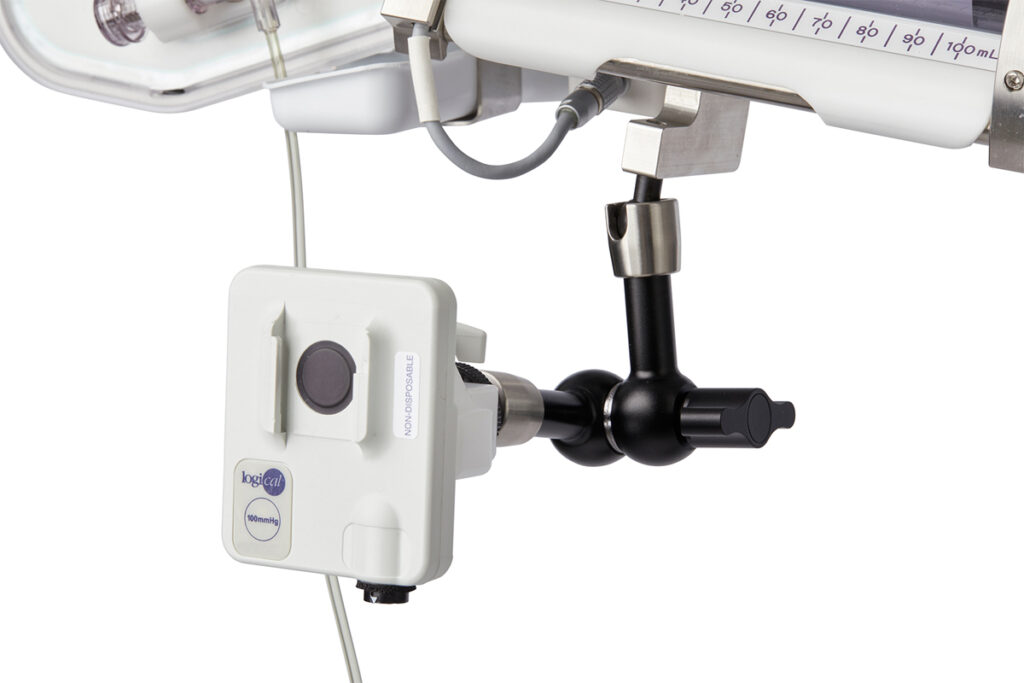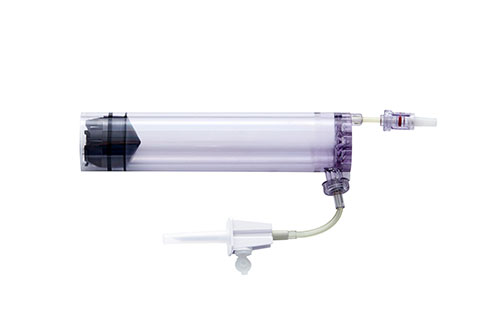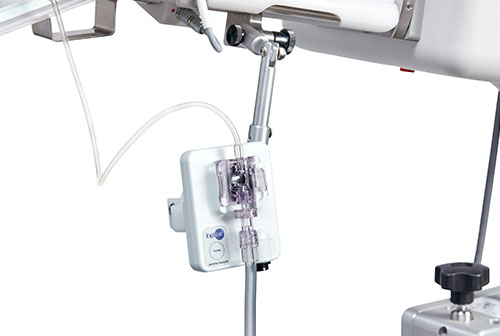ACIST CVi™
Contrast Delivery System
ACIST CVi™
Contrast Delivery System
CVi delivers the power to improve patient safety, minimizing the risk of contrast-induced acute kidney injury (CI-AKI) for coronary catheterizations when compared to manual injection of contrast media.
It’s the contrast injector for:
- Interventional cardiologists who want to regulate contrast injection flow and minimize risk of CI-AKI—also referred to as contrast induced nephropathy (CIN)
- Hospital administrators interested in cost containment through cath lab safety and efficiency and reducing potential patient post-procedure adverse events
Stability, Agility and Durability
New transducer arms are now available for ACIST CVi® Contrast Delivery systems
The new design has improved range of motion and is easily lockable in any position. An ergonomic wingnut provides quick and easy adjustment while the solid aluminum construction ensures durability.

Stability, Agility and Durability
New transducer arms are now available for ACIST CVi® Contrast Delivery systems
The new design has improved range of motion and is easily lockable in any position. An ergonomic wingnut provides quick and easy adjustment while the solid aluminum construction ensures durability.

Experience the Difference
AT X65L is the enhanced AngioTouch® kit for the ACIST CVi Contrast Delivery System designed to improve the performance of the hemodynamic signal11.
Increasing safety and operational efficiency
Increasing patient safety
Up to 30% reduction in CI-AKI vs. manual injection.1
CI-AKI incremental cost range: $13,294 to $14,266.2*
Increasing patient safety
~25% reduction in contrast use without compromising image quality when comparing 4 Fr to 6 Fr diagnostic procedures.3
Bleeding and contrast use were significantly reduced with 5 Fr catheters compared to 6 Fr.4
Increasing workplace safety
Up to 50% reduction in clinician radiation exposure by stepping back.5,6
Increasing workplace safety
Increasing operational efficiency
45 mL decrease per case when injector used.9
There is up to $0.30/mL savings in wasted contrast media.
Increasing operational efficiency
Average 5 min faster per procedure10
Time saved may allow for additional procedures to be performed in a day.10
*P<0.05 CVi vs. manual injection






Watch the overview
See system highlights and other CVi features.
* The cost was reported in 2010 USD and inflated to 2018 USD using the medical care component of the CPI index.
** The air column detection sensor is designed to aid the user in the detection of air in the injecting line, but it is not designed to replace the vigilance and care required of the operator in visually inspecting for air and clearing air.- Call J, Sacrinty M, Applegate R, et al. Automated contrast injection in contemporary practice during cardiac catheterization and PCI: effects on contrast-induced nephropathy. J Invasive Cardiol. 2006;18(10):469-474.
- Amin A, Sharpiro R, Novak E, et al. Costs of contrast induced acute kidney injury. Circulation: Cardiovascular Quality and Outcomes. 2018;6(suppl 1):A316.
- Khoukaz S, Kern M, Bitar S, et al. Coronary angiography using 4 Fr catheters with Acisted power injection. Catheterization and Cardiovascular Interventions. 2001;52:393-398.
- Polimeni A, Passafaro F, De Rosa S, et al. Clinical and procedural outcomes of 5-French versus 6-French sheaths in transradial coronary interventions. Medicine (Baltimore). 2015;94(52):e2170.
- Goldstein JA, Kern M, Wilson R. A novel automated injection system for angiography. J Interv Cardiol. 2001;14(2):147-152.
- Larsen AS, Osteras BH. Step back from the patient: reduction of radiation dose to the operator by the systematic use of an automatic power injector for contrast media in an interventional angiography suite. Acta Radiol. 2012;53(3):330-334.
- Klein LW, Tra Y, Garratt KN, et al. Occupational health hazards of interventional cardiologists in the current decade: results of the 2014 SCAI membership survey. Catheter Cardiovasc Interv. 2015;86(5):913-924.
- Holton M. Ergonomics revisited: carpal tunnel syndrome. https://www.cathlabdigest.com/articles/Erogonomics-Revisited-Carpal-Tunnel-Syndrome. Updated March 2005. Accessed: September 26, 2018.
- Minsinger KD, Kassis HM, Block CA. Meta-analysis of the effect of automated contrast injection devices versus manual injection and contrast volume on risk of contrast-induced nephropathy. Am J Cardiol. 2014;113(1):49-53.
- Lehmann C, Hotaling M. Saving time, saving money: a time and motion study with contrast management systems. J Invasive Cardiol. 2005;17(2):118-121;quiz 122.
- Data on file. TR-11392R. Based on an amplitude increase of 1.56mmHg and a significant p-value of 0.01 as compared to AT P65.
Prior to use, reference Instructions for Use, inside the product carton (when available) or at < enterwebsite.com> for more detailed information on safe use of the device.
Indications for Use:
The ACIST | CVi™ Contrast Delivery System is intended to be used for the controlled infusion of radiopaque contrast media for angiographic procedures.
Contraindications:
The ACIST | CVi™ Contrast Delivery System (CVi system) is not intended for use as a long-term infusion pump. The system is not intended to be used to inject any agents other than contrast media. The system should not be used to inject substances into nonvascular body cavities. Any applications of the system, other than those described in this manual, are inappropriate and should not be attempted. Do not add any components to the consumable kits or in conjunction with the catheter. No valves or other manifolds may be placed in-line between the ACIST-provided consumable kit and the catheter. ACIST-provided consumable kits are designed, manufactured, and tested for connection to catheters used in angiographic procedures. Do not use the system in the presence of flammable gases.
Important Safety Info:
The CVi System is designed to aid the physician in the injection of contrast media during angiography. It should be used with adequate radiographic imaging and where monitoring equipment for blood pressure and the electrocardiogram is available. Additionally, standard equipment for cardiopulmonary resuscitation and drugs for the treatment of contrast media-induced drug reactions should be present.It is necessary that the CVi system be operated by, or be under the immediate and direct supervision of a physician who is specifically trained in angiography and in the operation of this unit. System operation must be monitored at all times, and specific operational and mechanical integrity must be maintained to ensure patient safety.
For proper operation and to ensure equipment compatibility, use only accessories and options provided or specified by ACIST Medical Systems for use with the CVi system. To ensure proper operation of the syringe, viscosity limits must be observed. Do not allow the reusable syringe kit to sit loaded with contrast media longer than the maximum time recommended by the contrast manufacturer. Do not allow the reusable syringe kit to be used for more than five (5) procedures. Replace the automated manifold and hand controller kits after each procedure. Use of the syringe kit for more than five (5) procedures or re-use of the automated manifold and hand controller kits may result in cross contamination, risk of infection or device malfunction, for example, air ingress, leaks, or reduced performance. An air embolism can cause patient injury or death. Operator vigilance and care, along with a defined procedure, are essential to avoid injecting air and causing an air embolism. Before injections, clear all air from the entire patient kit and the angiographic catheter. Make sure that the exterior of the tubing is dry before inserting it into the air column detect sensor. If any fluid is present on the tubing’s exterior surface, the sensor may be unable to detect air. High flow rate injections can cause patient injury or death. Use extreme care when setting the flow rate to avoid unintentionally setting a high flow rate injection. When high flow rate injection is required, be sure to select a pressure setting that does not exceed the rated pressure of the selected catheter.



